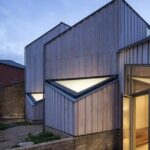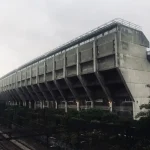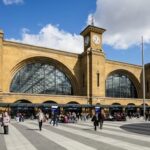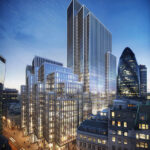London Olympics Media Centre building image, International Broadcast Centre project news, IBC 2012 design images
London 2012 Media Centre
IBC/MPC Building Development, UK design by Allies and Morrison architects
post updated 17 February 2024
London 2012 International Broadcast Centre completed
Design: Allies and Morrison
The construction of the International Broadcast Centre (IBC) has been completed.

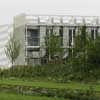
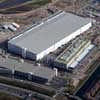
Olympics Media Centre : photos from Olympic Delivery Authority
15 July 2011
London Olympics Media Centre
The International Broadcast Centre venue is the fifth to be completed on the Olympic Park.
The 275m-long building will form part of the Main Media Complex – a 24-hour media hub which also includes the Main Press Centre (MPC). The complex will cater for over 20,000 broadcasters, photographers and print journalists – bringing the Games to an estimated four billion people worldwide.
It has been designed to be as flexible as possible to accommodate a range of potential tenants and uses after the Games.
A high street will support both the IBC and MPC, containing dedicated retail, leisure and support services, accessed only by accredited press and broadcasters. The complex will also have a catering village and a multi-storey car park links the two main venues together via a structure which includes a conference room for up to 700 people.
ODA Chairman John Armitt said: “The Olympic Park project is on schedule and within budget. Today’s announcement of the completion of the International Broadcast Centre (IBC) means that with over a year to go to the Games five of the six main venues on the site have now finished construction, allowing time for LOCOG to install overlay and run test events.
“The ODA has hit all of its milestones to date and we are firmly on track to deliver the venues and infrastructure required for the Games and in legacy as planned.”
Olympics Minister Hugh Robertson said: “The IBC is fundamental to the worldwide success of the Games housing thousands of the world’s media and sending pictures right across the world. As one of the largest venues on the Park, its completion with a year to go is a great achievement, and is yet another example of businesses across the country coming together to deliver for the United Kingdom.”
The Mayor of London Boris Johnson said: “The capital is going to be at the centre of global media attention during the summer of 2012, with thousands of broadcasters descending on London’s great sporting spectacular.
“As well as providing them with a world class facility to tell the story of the Games, we aim to make the fantastic International Broadcast Centre the focus of a new high-tech creative hub to benefit the capital for years to come.”
Ed. You have to wonder why this building doesn’t have more life about it. Allies and Morrison have a good pedigree for elegant, simple buildings but this doesn’t appear to match their normal standards.
With the compromises to the Aquatics Centre by Zaha Hadid Architects, the pedestrian station and the lack of spark in the main stadium it appears as though the Olympics will be ready on time but look unlikely to form an integrated piece of refined architecture. This is a wasted opportunity, the freedom inherent in these typologies should have resulted in a fantastic array of buildings.
Adrian Welch, e-architect Editor
Previously:
17 Nov 2010
Olympics Media Centre
The new images are released on the day the International Olympic Committee (IOC) Co-ordination Commission for London arrive for one of their regular inspection visits.
The ODA recently announced that the construction project is now 75 per cent complete and the main venues on track to be completed next summer – a year before the Games.
Latest aerial photos from the London Olympics site of the IBC / MPC Building:
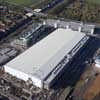
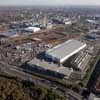
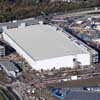
Aerial view of Olympics Media Centre : photos from Olympic Delivery Authority
18 Nov 2010
Olympic Park – View from local resident
Although some of the Olympic buildings have been designed with real flair and imagination, the boiler-room utility of the Media Centre suggests that its back-lot location and the political invisibility of the local population allowed the architects to offer a low-cost solution that would balance costs elsewhere. The wording of the Allies and Morrison release below is a classic example of “architect-speak” of the sort that ultimately serves to discredit the profession as a whole. It takes very little reading between the lines to triangulate the references to consultation with local people and the “design refinements developed with stakeholders” with the reaction of the project’s reluctant neighbours at the Leabank Square blog.
Owen Beith, Olympic Borough resident
Previously:
24 Jun 2009
London Olympics Media Centre Planning News
Planning green light for London 2012 media centre ‘big build’
The ‘big build’ of the International Broadcast Centre (IBC) and Main Press Centre (MPC) is on track as plans were approved by the Olympic Park Planning Committee last night. Under an earlier approval work on the foundations is already well underway, with piling now 90 per cent complete, and the buildings will start coming out of the ground shortly.
The IBC/MPC will support 20,000 broadcasters, photographers and journalists communicating the London 2012 Olympic and Paralympic Games to an audience of approximately four billion people worldwide. In legacy the facilities will create just under 900,000 square feet of business space with the potential to generate thousands of new jobs.
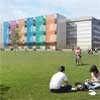
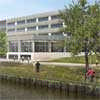
pictures from Olympic Delivery Authority
Local people and other stakeholders have been consulted throughout the planning process and as planned the detailed design of the external appearance of the IBC/MPC has been developed through the application stages.
Design refinements developed with stakeholders include:
– New cladding design and detailing for the 29,000 square metre MPC office block with more colour utilised, an emphasised legacy entrance and the building visually broken up into sections.
– New chequerboard cladding design for the 60,000 square metre IBC studios and smaller sections of screening over the gantry that runs alongside the building to break up the scale of the building visually.
– New cladding design for the permanent section of the media transport mall which remains in legacy.
Olympic Delivery Authority Chief Executive David Higgins said:
“The ‘big build’ of the IBC/MPC is right on track. The foundations are progressing at pace with over 90 per cent of the piling complete and following this important milestone buildings will start to come out of the ground. The IBC/MPC will provide a quality working environment for media during the Games while delivering flexible employment space for a range of potential legacy tenants and users.”
Sebastian Coe, Chairman of the London 2012 Organising Committee, said:
“This decision marks a significant step towards the provision of the best possible working environment and technology for the 20,000 members of the world’s broadcasters, press and photographers in the summer of 2012. Millions of people around the world rely on the international media to relay the stories of human endeavour on the field of play. The impressive facilities we have planned will give us the best possible foundations for telling all the stories from the London 2012 Games whilst leaving high performance workspace for the east of London.”
Olympics Minister Tessa Jowell said:
“With just over three years to go the big build is well and truly underway. The media centre will provide state-of-the-art facilities for thousands of press when they come to London in 2012 and help to relay the excitement around the world. After the Games the IBC/MP can then be modified for use by businesses and has the potential to be the beating heart of London’s growing digital economy.”
Elected Mayor of Hackney Jules Pipe said:
“We are pleased improvements have been made to the design of the IBC which enables the building to be more flexible for its legacy use. We welcome the ongoing commitment to refining the MPC design and finish to ensure a building of quality that can become the home for creative industries in legacy. We must now ensure the employment legacy vital to Hackney and East London is achieved and we will continue to work closely with our partners to secure this for our residents.”
‘big build’: IBC/MPC
Work started a month early in April on the foundations of the IBC/MPC, which already had planning approval. Over 2200 concrete piles, 90 per cent of the total planned, have already been sunk up to 24m into the ground. In the coming weeks work will start on the 275m long, 104m wide, 21m tall steel frame of the huge IBC studio building, which is big enough to house five jumbo jets. Over 4,500 tonnes of steel with up to 24m long plate girders are being produced and fabricated for the IBC in Dalton, North Yorkshire.
The IBC/MPC combines an innovative mixture of permanent and temporary elements during the Games and has been designed to be as flexible as possible to accommodate a range of potential legacy tenants and uses. The London Development Agency (LDA) has been leading the legacy planning and this work will be taken forward by the new Olympic Park Legacy Company which will begin operating fully later this year.
Construction is underway on the foundations of the IBC, MPC and media transport mall on the 370,000 sq metre site.
The MPC includes:
– 29,000 square metres of sustainable office space by the River Lea Navigation, providing four storeys of workspace for journalists and photographers during the Games.
– Innovatively designed flexibility that enables the building to be adapted in legacy for either a single tenant in the whole building or on each floor, as well as multiple tenants on each floor.
– A connected single strip of single storey buildings facing the canal that can be separated into ‘mews’ accommodation in legacy offering another type of quality business space in legacy.
– State-of-the-art utilities, power and digital connectivity during the Games and in legacy.
– innovations designed to meet demanding sustainable building standards in legacy including a 2,500 square metres ‘brown roof’ of gravel and moss to encourage invertebrates; 60% of non-drinking water to be collected from across the Olympic Park; habitats including over 100 bird and bat boxes.
The IBC includes:
– Around 52,000 square metres of studio space of two 8-10m high floors during the Games with a temporary gantry running along the building for technical equipment.
– 8000 square metres of offices over five floors at the front of the building.
– The flexibility in legacy to be separated into a number of units and for design features to be altered such as cladding replaced with windows.
Temporary Games time elements, most of which reduce the Games and legacy transformation costs, include:
– A 12,000 square metre catering village serving 50,000 meals a day 24 hours.
– A 200 metre long High Street between the MPC and IBC featuring outlets such as banks, newsagents, travel agents and a post office.
– A temporary Media Conference room between the IBC and MPC for up to 800 journalists.
A Media Transport Mall providing coach drop-off and car parking, accreditation and security screening during the Games will be halved in legacy to provide car parking spaces to legacy tenants alongside walking, cycling and public transport connections.
In February, the LDA and London 2012 partners released draft outline legacy plans for the park – called the Legacy Masterplan Framework (LMF). These are currently being assessed by the new Olympic Park Legacy Company following a consultation earlier this year. The Company will take over from and build on the solid foundation of the legacy work currently being taken forward by the LDA which has been developing plans since London’s successful bid to host the Games.
The LMF is part of a wider regeneration strategy for the area which also takes into account social and economic regeneration for the areas surrounding the Olympic Park. For more information about the consultation visit www.legacynow.co.uk
Peter Rogers, Chief Executive of the London Development Agency, said:
“This is another step in the media centre site becoming a major employment driver in legacy with a main focus on the creative industries.
“The design refinements along with the structural enhancements to be made after the Games will provide greater flexibility in splitting the building into different configurations for legacy tenants. We are delighted to have reached this milestone and look forward to a smooth transition of the project over to the Olympic Park Legacy Company.”
Previously released images of the 2012 London Olympics Media Centre building:
London 2012 Olympics International Broadcast Centre:
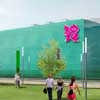
image from Olympic Delivery Authority
London 2012 Olympics Main Press Centre:
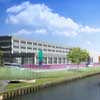
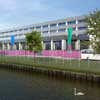
images from Olympic Delivery Authority
London 2012 Olympics Media Centre building : further details
Location: Stratford, London, England, UK
London Buildings
Contemporary London Architecture
London Architecture Designs – chronological list
London Architectural Tours by e-architect
London Olympic Stadium

image from Olympic Delivery Authority
London Olympics Velodrome
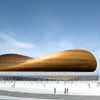
image from Olympic Delivery Authority
London 2012 Olympics Village

image from Olympic Delivery Authority
Comments / photos for the London 2012 Media Centre Building – UK Architecture design by Allies and Morrison architects page welcome.

